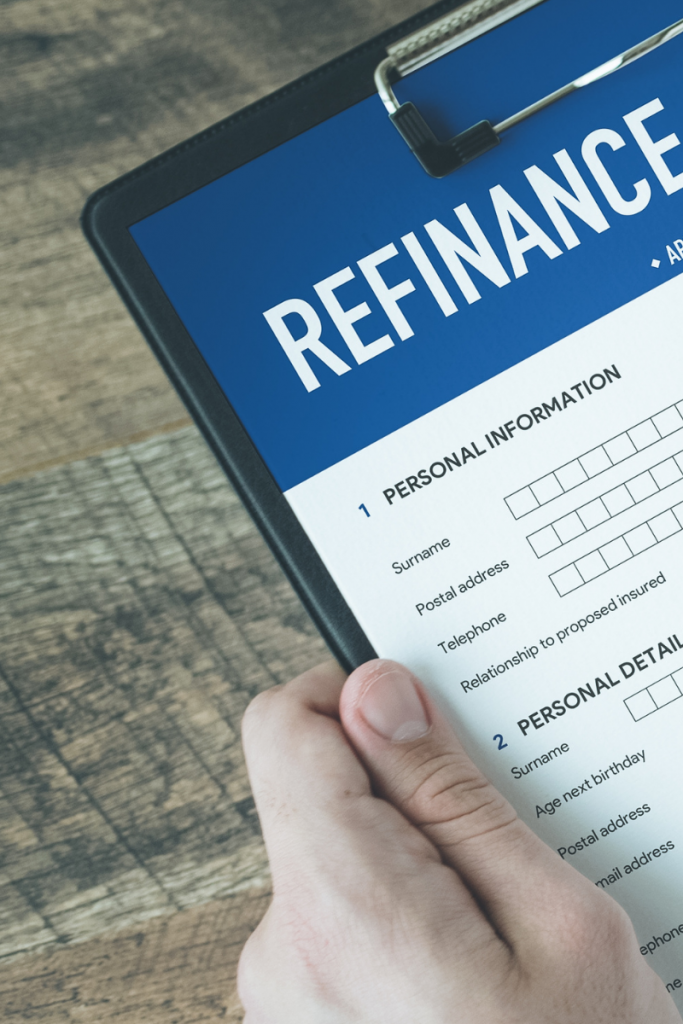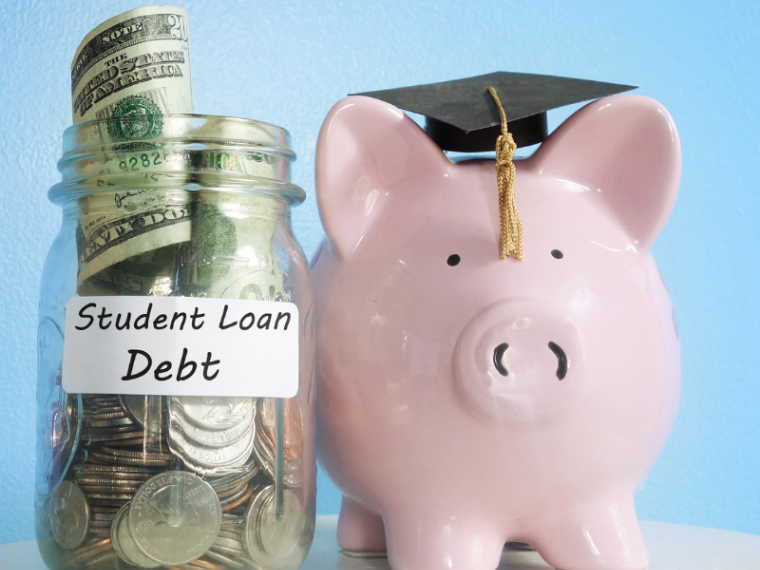Today we’re going to chat about a hot topic: student loans. Yes, student loan debt seems to be all the buzz on every news channel right now. To the disappointment of many, it seems like student debt may be around for a while, but there is something with those loans you can do right now to ease the burden a bit. Let’s chat about how to refinance student loans.
Without going out, pounding the pavement, and getting the facts from real people on the street, I’d have to say my hunch is that a good deal of debt that most Americans have to contend with is student loans. Actually, based on research published in March of this year, student loan debt is the second-highest average debt per American next to mortgages. Yikes!
Now the cost of a mortgage is slightly higher than most people’s college costs (but just barely right?). So it seems like an unfair fight. Third place is auto loans at a staggering $19,000 less than student loans.
Not only that, at $46,822 on average, student loan debt is over 1/3 the average debt for Americans 35-54. With rates as high as 12.59%, it is definitely worth looking at how to refinance student loans.
The first step in learning how to refinance student loans is to gain an understanding of what it means to refinance. For example, how does it differ from consolidation? What types of refinancing are there, and what does it cost?
14% of the forty million Americans with student loan debt owe more than $50,000! That is a huge blow to your budget and your personal finances. Refinancing your student loan debt may be the key to freeing up your budget, living more comfortably, or even getting out of debt sooner.

Consolidating vs Refinancing
When you look at the most common approaches to dealing with debt, there is bound to be some confusion. Debt consolidation can sometimes be misunderstood as refinancing when it is really just an alternative approach to making your outstanding debt more manageable.
When you consolidate debt, you take multiple outstanding balances and put them all into one big debt you owe. This is a useful tactic if you can wrangle a lower total interest rate for the biggest debts you owe.
Credit card consolidation is common when a bank will let you transfer balances for a promotional interest rate. Some offers will give you a year or 18 months with no interest on balance transfers.
The no-interest payment is tempting, but know that as soon as you make that transfer, the clock starts on paying that debt. At the end of the promotional period, you may wind up owing a lot more in interest on the remaining balance, especially if you continue to use the card for new purchases.
Debt consolidation is not always the right answer, and it’s not always the wrong answer. The same can be said for refinancing.
Refinancing is a tool at your disposal, and it keeps banks competitive. However, banks also make money off of refinancing, so the trick again is to make sure that the amount you pay puts you in a better place after the refinance than before. Refinancing your student loan under the right circumstances can give you a good financial advantage.
Refinancing for a Debt Advantage
Because the number of people with student loan debt is so high and the amount of debt is one of the greatest among the most common loans in America, it makes sense to seek some sort of advantage. Refinancing, in simple terms, is a legal way to change the terms of your original loan agreement.
This is done by essentially taking out a second loan to cover the first with different requirements. The point is that these requirements will be less stringent than those of the original loan. One cause of this is competition among bankers eager to acquire new business. A strong factor in your eligibility for refinancing is an improved credit score.
A dramatically higher credit score is one of the first steps in how to refinance student loans.
When you refinance, you can take advantage of new terms in a couple of different ways. First, you can make the debt easier to pay off, for example, with a lower interest rate. Less interest means more of your money goes toward principal, and the debt shrinks faster. You might be able to take 8% off of the interest rate if your current loan charges a higher rate of interest.
Another reason to refinance that can get you a better financial advantage is not necessarily lower interest but a longer payoff term. This could allow you to pay less on your minimum balance month after month and therefore free up some cash in your budget for other things you would prefer to spend your income on.
Types of Refinancing
Low-Interest Rate
One of the worst things about debt is high interest. It can keep you from paying off what you borrowed if the principal, the actual amount of the loan, barely gets touched by your payments. With high interest, your monthly payments tend to cover little more than that, which keeps you in debt longer as you try in vain to dig yourself out.
One way to get out of debt faster is to refinance for a deal with lower interest. This becomes possible if you have an improved credit score or simply find a lender who offers lower rates in general. Depending on how high your interest is, you may have an easier or harder time getting the rate down.
The average interest rate for student loans is around 5% for a federal loan and about 9% for private loans. But this is just an average, and your credit score and whether or not you had a cosigner has a lot to do with what your rate ends up being. If your situation has improved (if the loan did its job), you should be positioned to get a better deal now than you did before you borrowed the money!
Pay Less Money Each Month
Another way to look at paying back your loan is the loan’s effect on your monthly budget. If you are less concerned with paying off the loan and more concerned with your monthly bottom line, refinancing your student loan for a lower minimum balance may be the right option for you.
This sort of refinancing will allow you to pay less each month, although it will increase the amount you pay on the loan over time. However, just because it technically raises the overall cost of the loan does not mean that it is necessarily the wrong decision. If you need to free up cash flow for whatever reason, lowering your monthly payments on your student loan may be a good solution.
However, you should consider other options first, such as reducing the cost of cable, insurance, etc.

Is There A Cost To Refinance?
The short answer is no – there is no cost to refinance a student loan. The only cost is found in the interest rate. There are also so-called hidden costs that you will find in the loan agreement, which include basic fees for things like late payment and even early payment in some cases.
The late payment fee is pretty self-explanatory and predictable. You may not have ever heard of an early payment penalty, however. Early payment penalties are when you zero out your loan before your term is up. This is a measure to protect the investment of the lender because interest is how they make their money.
The other type of fee you should be aware of is a collection fee if you default on the loan. Generally speaking, however, student loan refinancing is a good bet for lenders. And since your credit history plays a part in refinancing, a default on your loan is unlikely, especially when many lenders also offer perks like unemployment protection.
Origination Fees
Origination fees are the cost of processing a loan or a payment made in order to transact the loan. Despite the other potential fees and penalties, origination fees are rare, and you should avoid banking institutions that charge you to process an application to refinance a student loan. Origination fees are normal with other types of loans but not with student loans.
How To Refinance Student Loans
Once you decide you want to refinance a student loan, getting started is easy. There are websites dedicated to providing you with the best options depending on the criteria that are important to you. One company, Juno, will help you refinance your student loans for free.
Here’s how Juno works:
- Juno brings together students, graduates, and families that want a better rate on their student loans.
- They then ask lenders to compete for their business on behalf of the students and past students.
- Juno shares the exclusive deal with their members.
The best part about Juno is that it is absolutely FREE for anyone that is refinancing. Click here to learn more about Juno and how you can use group buying power to save money on your student loans.
If you know you want to refinance, consider your credit score before taking action. Most banks or credit accounts now offer a free credit score that you can access every month.
Typically when you are paying off debt, you do not need to concern yourself with your credit score. However, refinancing is different because your score will determine how much more you can save on the transaction.
To improve your score, you’ll need to adjust your debt to income ratio, which takes us back to finding other ways to tighten your belt before looking into how to refinance student loans for answers.
To apply to refinance a student loan, you’ll need proof of employment, proof of residence, and proof of graduation. You’ll also need a government-issued ID. It may also be helpful to have a cosigner if you need better terms. That’s it. It only takes a few minutes to refinance your student loans with Juno.

By the way – if you’re trying to pay off debt, I’ve got a completely FREE resource that will help motivate and guide you along your debt-free journey. Sign up below to grab your debt free roadmap! I’ll be sharing with you exactly how my husband and I paid off over $111,000 in debt on 2 teacher salaries while growing our family!


